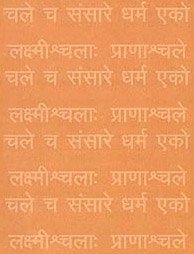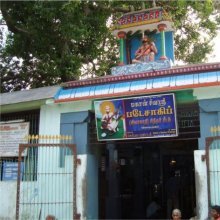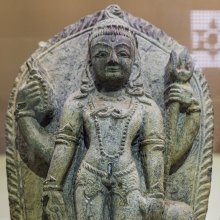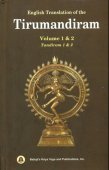Shaivism, Śaivism: 8 definitions
Introduction:
Shaivism means something in Hinduism, Sanskrit, the history of ancient India. If you want to know the exact meaning, history, etymology or English translation of this term then check out the descriptions on this page. Add your comment or reference to a book if you want to contribute to this summary article.
Images (photo gallery)
In Hinduism
Shaivism (Shaiva philosophy)
Source: Shodhganga: Temple management in the ĀgamasŚaivism refers to the Śaiva tradition.—There are several schools of Śaivism with specific characteristics. The major ones are Pāśupata, Lakulīśa, Soma and Śaiva. Śaiva is in turnclassified into Siddhānta, Dakṣiṇa and Vāma. Dakṣina-śaiva is classified into Aghora and Bhairava with the latter differentiated into Mahāvrata, Kāpālika, Kālāmukha and Pāśupata. Vāma-śaiva is classified into Anādi, Pūrva and Paścima. Siddhānta-śaiva is considered the final culmination of the Śaiva philosophy.

Shaiva (शैव, śaiva) or Shaivism (śaivism) represents a tradition of Hinduism worshiping Shiva as the supreme being. Closely related to Shaktism, Shaiva literature includes a range of scriptures, including Tantras, while the root of this tradition may be traced back to the ancient Vedas.
Vedanta (school of philosophy)
Source: Shodhganga: Siva Gita A Critical StudyShaivism (Śaivism) refers to the religion followed by those who worship Śiva as supreme God. Oldest of the four sects of Hinduism. The earliest historical evidence of Śaivism is from the 8000-year-old Indus Valley civilization in the form of the famous seal of Śiva as Lord Paśupati, seated in a yogic pose.
There are many schools of Śaivism, six of which are:—
- Śaiva Siddhanta (Śaivasiddhanta),
- Pāśupata Śaivism,
- Kashmir Śaivism,
- Vīra Śaivism (Vīraśaivism),
- Siddha Siddhānta (Siddhasiddhānta),
- Śiva Advaita (Śivādvaita).
They are based firmly on the Vedas and Śaiva Āgamas, and have much in common, including the following principal doctrines:
- the five powers of Śiva-creation, preservation,destruction, revealing and concealing grace;
- the three categories: pati, paśu and pāśa ( “God, souls and bonds”);
- the three bonds: āṇava, karma and māyā;
- the three fold powers of Śiva: icchā-śakti, kriyā-śakti and jñāna-śakti;
- the thirty six tattvas, or categories of existence;
- the need for initiation from a Satguru,
- the power of mantra’,
- the four pādas (stages): caryā (selfless service), kriyā (devotion), yoga (meditation), and jñāna (illumination);
- the belief in the pañcākṣara as the foremost mantra, and in rudrākṣa and vibhūti as sacred aids to faith;
- belief in Satguru (preceptor), Śivaliṅga (object of worship) and Saṅgama (company of holy persons).

Vedanta (वेदान्त, vedānta) refers to a school of orthodox Hindu philosophy (astika), drawing its subject-matter from the Upanishads. There are a number of sub-schools of Vedanta, however all of them expound on the basic teaching of the ultimate reality (brahman) and liberation (moksha) of the individual soul (atman).
General definition (in Hinduism)
Source: WikiPedia: HinduismShaivism (शैव धर्म): Shaivism names the oldest of the four sects of Hinduism. Followers of Shaivism, called "Shaivas", and also "Saivas" or "Saivites", revere Shiva as the Supreme Being.
India history and geography
Source: archive.org: Social Life In Medieval RajasthanŚaivism in Rājasthān.—After the 15th century, the cult of Brahmā seems to have merged in that of Śiva, Viṣṇu or Sun—a conception of Tripuruśa. This is evidenced by the images of Bhāwal (Medtā), Rāṇpur (Mārwār) and Rāmgarh (Kotāh) in which these deities have been combined with that of Brahmā on account of the growing influence of Śaivism and Vaiṣṇavism.
Source: archive.org: Nilamata Purana: a cultural and literary study (history)Śaivism refers to a system of worship once practised in ancient Kashmir (Kaśmīra) according to the Nīlamatapurāṇa, referring to some treatises entitled Śivadharmas which, evidently, must have contained religious duties regarding the cult of Śiva. That Śiva was worshipped in early Kaśmīra is beyond doubt. The Mahābhārata states specifically that Śiva and Umā may be propitiated in Kaśmīra at the lake Vātikaṣaṇḍa. Kalhaṇa’s Rājataraṅgiṇī contains innumerable references to Śiva and Śiva-images erected by kings, ministers and other people of Kaśmīra.
Source: What is India: Inscriptions of the ŚilāhārasŚaivism during the reign of the Śilāhāra dynasty (r. 765-1215 A.D.).—The Śilāhāras were ardent Śaivas. Most of their grants were made for the worship of Śiva. Jhañjha of North Koṅkaṇ is said to have built twelve temple of that god, evidently at the sites of the twelve Jyotirliṅgas, and named them after himself. Some Śilāhāras undertook pilgrimages to the well-known Śiva-khetra Somanātha-paṭṭana, and made grants of land in their kingdom to the god Someśvara. Even ministers and common people constructed temples of Śiva and named the god after themselves.
As the Śilāhāras of North and South Koṅkaṇ were ardent Śaivas, they invited Śaiva ascetics to their capital even from distant places, and made liberal grants to them. It is interesting to note that Ātreya, who received the grant recorded in the Khārepāṭaṇ plates dated Śaka 930 of the Śilāhāra king Raṭṭarāja, was a disciple of the learned Śaiva ascetic Ambhojaśambhu, who belonged to the Karkaroṇī branch of the Mattamayūra clan.
Source: Shodhganga: Temple management in the Āgamas (history)Śaivism mainly refers to the Śaiva tradition (worship of Śiva in the form of Śivaliṅga). Seals found at the Indus-Sarasvati sites display several elements of Śaiva symbolism. The figure of a male seated in a yogic posture with a trident head-dress, surrounded by animals has been termed Proto-Śiva, as it corresponds closely to Śiva’s aspects of being Śūlapāṇi, Paśupatināth and a yogi. Another seal, termed the seal of Divine Adoration, depicts a female within a tree, interpreted as a female deity, being supplicated by a male, attended in the foreground by seven females with elaborate headgear, resembling the later saptamātṛkās.
In historical times, the Buddha is said to have been a Śaiva in his pūrvāśrama. Greek writers traveling with Alexander mention serpent worship with iron tridents at Taxila. Kaḷhaṇa’s Rājataraṅgiṇī (as cited in Jogesh Chunder Dutt, 1879) mentions that the emperor Aśoka (272-232 BCE) made repairs and added a stone wall to the temple of Śiva Vijayeśvara, one of the primary deities of Kashmir. He is also said to have established a temple of Śiva Aśokeśvara.
Source: Shodhganga: The saurapurana - a critical study (history)Shaivism is perhaps the oldest religious cult in India, based on the ideals of renunciation, asceticism self-mastery and self-realisation. The time when these ideals captivated the human mind can’t be historically ascertained. The early Vedic texts refer in many places to homeless, wandering ascetics, pursuing the path of peace and tranquility through the control of speech, normal desires and emotion and the practice of austerity, meditation and self-absorption.
The process of its evolution was undoubtedly gradual and several literary data of the pre-christian period seem to indicate the stages of its growth and development. Panini in one of his sutras (4.1.112) seems to refer to the followers or worshippers of Shiva.
During the epic period Shaivism attained considerable importance. In the Ramayana, Ravana is stated to have worshipped Shivalinga. The Mahabharata is also devoted to Shiva-worship . We have two lauds of Shiva in this great epic, one giving him a thousand and the other a thousand and eight names. Though the epic-religion is marked by the rising Vaishnavism and Shaivism there was no antagonism between the two Gods of both the religion, because Shiva is very often identified with Vishnu and Vishnu as Shiva

The history of India traces the identification of countries, villages, towns and other regions of India, as well as mythology, zoology, royal dynasties, rulers, tribes, local festivities and traditions and regional languages. Ancient India enjoyed religious freedom and encourages the path of Dharma, a concept common to Buddhism, Hinduism, and Jainism.
See also (Relevant definitions)
Ends with: Kashmir Shaivism.
Full-text (+2401): Mala, Tantraloka, Nayanar, Somananda, Anushaiva, Avantarashaiva, Pashupata, Kshemaraja, Mantramarga, Diksa, Pralayakalar, Kancipura, Kantan, Pinda, Meru, Samidh, Prakasha, Bhima, Sadhaka, Ganapati.
Relevant text
Search found 59 books and stories containing Shaivism, Śaivism, Saivism; (plurals include: Shaivisms, Śaivisms, Saivisms). You can also click to the full overview containing English textual excerpts. Below are direct links for the most relevant articles:
Lakulisha-Pashupata (Philosophy and Practice) (by Geetika Kaw Kher)
Pasupata History (Introduction) < [Chapter 1 - The Historical Context]
Overall Structure and Methodological considerations < [Introduction]
Cidgaganacandrika (study) (by S. Mahalakshmi)
Part 15 - Fifteen states formed by Jāgrat, Svapna, Suṣupti and Turīya < [Philosophy of Kashmir Tantric System]
Part 5 - Three Upayas (means to enter universal God consciousness) < [Philosophy of Kashmir Tantric System]
Part 3 - Significant concepts of Kashmir Saivism < [Philosophy of Kashmir Tantric System]
Expiatory Rites in Keralite Tantra (by T. S. Syamkumar)
1.8 (b). Expiatory Rites in Prāyaścittasamuccaya < [Chapter 2 - Expiatory Rites in Āgamic Literature]
Introduction (Expiatory Rites in Āgamic Literature) < [Chapter 2 - Expiatory Rites in Āgamic Literature]
1.4. Expiatory Rites In Mataṅgaparameśvara-āgama < [Chapter 2 - Expiatory Rites in Āgamic Literature]
Gitartha Samgraha (critical Study) (by Partha Sarathi Sil)
4. Tattvas (Principles) of Kashmir Śaivism in the Gītārthasaṅgraha < [Chapter 3 - A Brief Sketch of Kashmir Śaivism]
3. Tattvas (Principles) of Kashmir Śaivism < [Chapter 3 - A Brief Sketch of Kashmir Śaivism]
The Religion and Philosophy of Tevaram (Thevaram) (by M. A. Dorai Rangaswamy)
Nayanar 34: Sakkiya (Cakkiya) < [Volume 4.1.1 - A comparative study of the Shaivite saints the Thiruthondathogai]
Chapter 3 - The final goal < [Volume 4.2.3 - Philosophy of God]
Nayanar 19: Tiru Kurippu Thonda (Tirukkuripputtontar) < [Volume 4.1.1 - A comparative study of the Shaivite saints the Thiruthondathogai]
The Lingayats-Their Religion and Literature < [May 1937]
Bhaavas in Vaishnavism and Saivism: A Comparative Study < [October – December, 1981]
Somnath < [July 1951]
Related products






